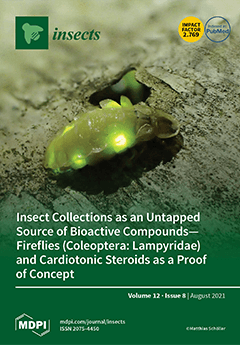β-1,3-glucan recognition proteins (βGRPs) as pattern recognition receptors (PRRs) play an important role in recognizing various pathogens and trigger complicated signaling pathways in insects. In this study, we identified a
Bombyx mori β-1,3-glucan recognition protein gene named
BmβGRP4, which showed differential expression,
[...] Read more.
β-1,3-glucan recognition proteins (βGRPs) as pattern recognition receptors (PRRs) play an important role in recognizing various pathogens and trigger complicated signaling pathways in insects. In this study, we identified a
Bombyx mori β-1,3-glucan recognition protein gene named
BmβGRP4, which showed differential expression, from a previous transcriptome database. The full-length cDNA sequence was 1244 bp, containing an open reading frame (ORF) of 1128 bp encoding 375 amino acids.
BmβGRP4 was strongly expressed in the larval stages and highly expressed in the midgut of
B. mori larvae in particular. After BmNPV infection, the expression of
BmβGRP4 was reduced significantly in the midgut. Furthermore, a significant increase in the copy number of BmNPV was observed after the knockdown of
BmβGRP4 in 5th instar larvae, while the overexpression of
BmβGRP4 suppressed the proliferation of BmNPV in BmN cells. Subsequently, the expression analysis of several apoptosis-related genes and observation of the apoptosis morphology demonstrated that overexpression of
BmβGRP4 facilitated apoptosis induced by BmNPV in BmN cells. Moreover,
BmβGRP4 positively regulated the phosphatase and tensin homolog gene (
BmPTEN), while expression of the inhibitor of apoptosis gene (
BmIAP) was negatively regulated by BmβGRP4. Hence, we hypothesize that BmNPV infection might suppress
BmPTEN and facilitate
BmIAP to inhibit cell apoptosis by downregulating the expression of
BmβGRP4 to escape host antiviral defense. Taken together, these results show that
BmβGRP4 may play a role in
B. mori response to BmNPV infection and lay a foundation for studying its functions.
Full article






